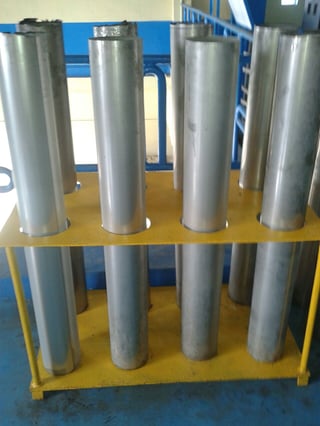Electrowinning is the process of ‘winning’ dissolved metals from solution by passing an electrical current through an electrolyte containing said metal. The fundamentals of the electrowinning process have been discussed in a previous blog. The relative ease of recovery depends on the electrochemical potential of the target metal relative to the Standard Hydrogen Electrode (SHE) which is defined by the following reaction:
2H++2e– --> H2
The standard reduction potential (E0) of SHE is arbitrarily defined as 0.0 Volts. The arrangement of the reduction potentials of elements relative to SHE is known as the Electrochemical Series. Metals that have more positive reduction potentials relative to SHE are more likely to acquire electrons and
To download fill out the form below
The efficiency of electrowinning any metal, including Nickel, depends on a variety of factors including the concentration of metal in the electrolyte, current density, temperature, pH, conductivity, impurities, and so on. If the electrochemical potential is sufficiently positive, these factors become less important. With

The concentration of dissolved Nickel in the electrolyte should be maintained relatively constant and should not vary throughout the course of the electrowinning process. This in itself is a tall order since the very nature of the electrowinning process involves the depletion of Nickel cations from solution to produce a Nickel plate according to the following cathodic reaction:
Ni2+ + 2e– --> Ni
Furthermore, considering both the anodic and cathodic reactions, the overall electrochemical reaction results in the production of acid (H+):
2Ni2++2H2O --> 2Ni +4H++O2
Unless the pH is carefully controlled, the production of acid at the anode will result in the re-dissolution of nickel which decreases the apparent current efficiency (CE) and needless to say the overall recovery efficiency. Conventional Nickel electrowinning cells overcome this by separating the anodic and cathodic compartments of the

The temperature of the solution should also be carefully controlled to avoid wide fluctuations that will affect the quality of the Nickel plate. The optimum current density (CD) needs to be applied to ensure efficient production rates without overstressing the deposit causing it to become brittle. To add insult to injury, if there are impurities present in the electrolyte whose electrochemical potential is similar or more positive than Nickel, they will surely deposit resulting in a
Despite all these complications, operators are keen to recover Nickel due to its relatively high value compared to other base metals, and the ease of sale of high purity cathode to
Until quite recently there wasn’t,







